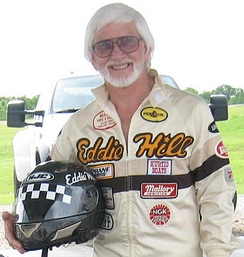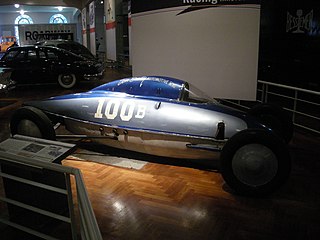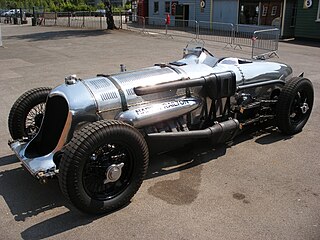Related Research Articles

Drag racing is a type of motor racing in which automobiles or motorcycles compete, usually two at a time, to be first to cross a set finish line. The race follows a short, straight course from a standing start over a measured distance, most commonly 1⁄4 mi, with a shorter, 1,000 ft distance becoming increasingly popular, as it has become the standard for Top Fuel dragsters and Funny Cars, where some major bracket races and other sanctioning bodies have adopted it as the standard. The 1⁄8 mi is also popular in some circles. Electronic timing and speed sensing systems have been used to record race results since the 1960s.

Donald Glenn Garlits is an American race car driver and automotive engineer. Considered the father of drag racing, he is known as "Big Daddy" to drag racing fans around the world. A pioneer in the field of drag racing, he perfected the rear-engine Top Fuel dragster, an innovation motivated by the loss of part of his foot in a dragster accident. This design was notably safer since it put most of the fuel processing and rotating parts of the dragster behind the driver. The driver was placed in front of nearly all the mechanical components, thus protecting him and allowing him to activate a variety of safety equipment in the event of catastrophic mechanical failure or a fire. Garlits was an early promoter of the full-body, fire-resistant Nomex driving suit, complete with socks, gloves, and balaclava.

Funny Car is a type of drag racing vehicle and a specific racing class in organized drag racing. Funny cars are characterized by having tilt-up fiberglass or carbon fiber automotive bodies over a custom-fabricated chassis, giving them an appearance vaguely approximating manufacturers' showroom models. They also have the engine placed in front of the driver, as opposed to dragsters, which place it behind the driver.

Top Fuel is a type of drag racing whose dragsters are the quickest accelerating racing cars in the world and the fastest sanctioned category of drag racing, with the fastest competitors reaching speeds of 338 miles per hour (544.0 km/h) and finishing the 1,000 foot (304.8 m) runs in 3.62 seconds.

Michael Lee "Mickey" Thompson was an American auto racing builder and promoter.

Pro stock is a class of drag racing featuring "factory hot rods". The class is often described as "all motor", due to the cars not using any form of forced induction such as turbocharging or supercharging, or other enhancements, like nitrous oxide, along with regulations governing the modifications allowed to the engines and the types of bodies used.
The Tasmanian Devil was the name of a drag racing car in the 1960s, named after the Tasmanian Devil cartoon character.
Pacers Auto, Inc.® was a popular, record-setting drag racing team in the early 1950s and 1960s.

The Wally Parks NHRA Motorsports Museum, located in Fair plex, Los Angeles County, houses a collection of memorabilia, automobiles, and motorcycles related to the sport of hot-rodding.

Eddie Hill is an American retired drag racer who won numerous drag racing championships on land and water. Hill had the first run in the four second range (4.990 seconds), which earned him the nickname "Four Father of Drag Racing." His other nicknames include "The Thrill", "Holeshot Hill", and "Fast Eddie". In 1960, he set the NHRA record for the largest improvement in the elapsed time (e.t.) when he drove the quarter mile in 8.84 seconds to break the previous 9.40-second record.

A gasser is a type of hot rod originally used for drag racing. This type of car originated in United States in the late 1950s and continued until the early 1970s. In the days before Pro Stock, the A/Gas cars were the fastest stock-appearing racers around.
The Banks Sidewinder is a land speed record vehicle that was built by Gale Banks Engineering in 2001. Based on a Dodge Dakota pickup truck, the Banks Sidewinder became the fastest pickup ever when it set a speed record of 213.583 mph (343.729 km/h) at Bonneville in October 2001.
The So-Cal Speed Shop is a specialty parts shop for hot rods, specializing in cars built in the 1940s. It offers parts online, as well as a number of retail stores in the western United States and two in Canada. The headquarters is located in Pomona, California.
Robert E. Meeks was an American hot rod engine builder and chief mechanic to famed hot rod driver and auto parts designer Vic Edelbrock. Meeks was pioneer in the early days of hot-rodding and was considered the first Ford flathead guru.
JEGS High Performance is the second largest mail order company of automotive equipment in the United States. It sells performance auto parts, aftermarket accessories, tools, and race apparel. JEGS was founded by Jeg Coughlin Sr. in 1960 as a small speed shop. Jeg's remained family owned and operated until 2022 when a majority stake of the company was purchased by Greenbriar Equity Group. Over 60 years, JEGS has expanded to include a 250,000-square-foot (23,000 m2) warehouse, two mail order locations, retail store & Team JEGS Race Team. The company has approximately 350 employees.

Honest Charley was an American businessman and pioneer in the high performance automotive parts industry. Born Charles Edward Card Jr., he was known throughout the racing and hot rod communities by the trade name Honest Charley. In 1948 he created the Honest Charley's Speed Shop in Chattanooga, Tennessee in the United States. The company became well known for its unique and entertaining catalogs which were originally hand drawn. Honest Charley's also attracted the attention of the aftermarket parts industry for its innovative distribution techniques. He was a racing enthusiast, patron and sponsor. He was a USAC Life Time Member with member number 121 and early member of the Indy 500 Old Timers Club. In 1970 he became the second inductee into Specialty Equipment Market Association (SEMA) Hall of Fame.

A Lakester is a car with a streamlined body but with four exposed wheels. It is most often made out of a modified aircraft drop tank. The main attraction is the drop tank's excellent aerodynamics due to it being streamlined for its original use on aircraft. Building lakesters became popular after World War II when surplus drop tanks were available cheaply.

An aero-engined car is an automobile powered by an engine designed for aircraft use. Most such cars have been built for racing, and many have attempted to set world land speed records. While the practice of fitting cars with aircraft engines predates World War I by a few years, it was most popular in the interwar period between the world wars when military-surplus aircraft engines were readily available and used to power numerous high-performance racing cars. Initially powered by piston aircraft engines, a number of post-World War II aero-engined cars have been powered by aviation turbine and jet engines instead. Piston-engined, turbine-engined, and jet-engined cars have all set world land speed records. There have also been some non-racing automotive applications for aircraft engines, including production vehicles such as the Tucker 48 and prototypes such as the Chrysler Turbine Car, Fiat Turbina, and General Motors Firebirds. In the late 20th century and into the 21st century, there has also been a revival of interest in piston-powered aero-engined racing cars.
Top Gas (T/G) is a former NHRA drag racing professional class.
Altered is a former National Hot Rod Association (NHRA) drag racing class and a current drag racing chassis configuration that forms the basis of many classes of NHRA Competition Eliminator.
References
- ↑ Hot Rod, January 2024, pp.18 and 82.
- ↑ Engerud, Ivar (9 March 2021). "Hot-rod-legende Alex Xydias (98): – Jeg skjønner ikke at jeg turte. Jeg fikk så vidt presset meg på plass i fronten". finansavisen.no (in Norwegian).
- ↑ Madigan, Tom. Edelbrock: Made in USA, Tehabi Books, 2005.
- ↑ Browne, Ray B.; Browne, Pat, eds. (2001). The guide to United States popular culture. Bowling Green, OH: Bowling Green State University Popular Press. ISBN 0879728213. OCLC 44573365.
- ↑ Hot Rod, January 2024, pp.18 and 82.
- ↑ Oilstick.com NHRA museum article Groak, Bill, 2004.
- ↑ Vaughn, Mark (23 March 2022). "Hot Rod Hero Alex Xydias Turns 100!". Autoweek . Retrieved 27 November 2022.